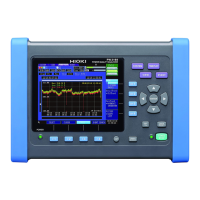12
Voltage unbalance factor/ Current unbalance factor (negative-phase, zero-phase)
TIME PLOT
Display items Voltage unbalance factor : Negative-phase unbalance factor, zero-phase unbalance factor
Current unbalance factor : Negative-phase unbalance factor, zero-phase unbalance factor
Measurement method Calculated using various components of the three-phase fundamental wave (line-to-line voltage) for three-phase 3-wire
(3P3W2M, 3P3W3M) and three-phase 4-wire connections
Sampling frequency 200kHz
Measurement range Voltage unbalance factor : Component is V and unbalance factor is 0.00% to 100.00%
Current unbalance factor : Component is A and unbalance factor is 0.00% to 100.00%
Measurement accuracy Voltage unbalance factor : ±0.15%
Current unbalance factor : —
Voltage DC value (ch4 only)
TIME PLOT
EVENT
Measurement method Average value during approx. 20ms aggregation synchronized with the reference channel (CH4 only)
Sampling frequency 200kHz
Measurement range, resolution 600.00V, 0.01V
Measurement accuracy ±0.3%rdg. ±0.08%f.s.
Active energy /Reactive energy
TIME PLOT
Display items
Active energy
: WP+ (consumption), WP- (regeneration); Sum of multiple channels
Reactive energy
: WQLAG (lag), WQLEAD (lead); Sum for multiple channels Elapsed time
Measurement method Measured every 10 cycles (50 Hz) or 12 cycles (60 Hz)
Integrated separately by consumption and regeneration from active power
Integrated separately by lag and lead from reactive power
Integration starts at the same time as recording
Recorded at the specied TIMEPLOT interval
Sampling frequency 200kHz
Measurement range, resolution Depends on the voltage × current range combination; see Input specications
Measurement accuracy
Active energy
: Active power measurement accuracy ±10 dgt.
Reactive energy
: Reactive power measurement accuracy ±10 dgt.
Cumulative time accuracy: ±10 ppm ±1s (23°C [73°F])
Power factor /Displacement power factor
TIME PLOT
EVENT
Display items Displacement power factor of each channel and its sum value for multiple channels
Measurement method Power factor : Calculated from RMS voltage U, RMS current I, and active power P
Displacement power factor :
Calculated from the phase difference between the fundamental voltage wave and the fundamental current wave
Lag phase (LAG: current lags voltage) and Lead phase (LEAD: current leads voltage
Sampling frequency 200kHz
Measurement range, resolution -1.0000 (lead) to 0.0000 to 1.0000 (lag)
Active power/ Apparent power/ Reactive power
TIME PLOT
EVENT
Display items Active power :
Active power for each channel and sum value for multiple channels.
Sink (consumption) and Source (regeneration)
Apparent power
: Apparent power of each channel and its sum for multiple channels
No polarity
Reactive power
: Reactive power of each channel and its sum for multiple channels
Lag phase (LAG: current lags voltage) and Lead phase (LEAD: current leads voltage)
Measurement method Active power : Measured every 10 cycles (50 Hz) or 12 cycles (60 Hz)
Apparent power
: Calculated from RMS voltage U and RMS current I
Reactive power
: Calculated using apparent power S and active power P
Sampling frequency 200kHz
Measurement range, resolution Depends on the voltage × current range combination; see Input specications
Measurement accuracy Active power : ±0.2% rdg.±0.1%f.s. + clamp-on sensor accuracy
Apparent power
: ±1 dgt. for calculations derived from the various measurement values
Reactive power
: ±1 dgt. for calculations derived from the various measurement values
Current DC value (ch4 only; when using compatible sensor)
TIME PLOT
EVENT
Measurement method Average value during approx. 200ms aggregation synchronized to reference channel (CH4 only)
Sampling frequency 200kHz
Measurement range, resolution Based on clamp-on sensor in use (when using compatible sensor)
Measurement accuracy ±0.5% rdg.±0.5%f.s. + clamp-on sensor accuracy
High-order harmonic voltage component/ High-order harmonic current component
HIGH-ORDER HARM
TIME PLOT
EVENT
Display items For single incidents and continuous transient incidents
High-order harmonic voltage component value
High-order harmonic current component value
For continuous incidents
High-order harmonic voltage component maximum value
High-order harmonic current component maximum value
High-order harmonic voltage component period
High-order harmonic current component period
Measurement method The waveform obtained by eliminating the fundamental component is calculated using the true RMS method during 10
cycles (50 Hz) or 12 cycles (60 Hz) of the fundamental wave
Sampling frequency 200kHz
Measurement range, resolution High-order harmonic voltage component : 600.00V, 0.01V
High-order harmonic current component : Based on clamp-on sensor in use; See Input specications
Measurement bandwidth 2kHz (-3dB) to 80kHz (-3dB)
Measurement accuracy High-order harmonic voltage component : ±10%rdg. ±0.1%f.s.
High-order harmonic current component : ±10% rdg.±0.2%f.s. + clamp-on sensor accuracy
Harmonic voltage/ Harmonic current (including fundamental component)
TIME PLOT
EVENT
Display items Select either RMS or content percentage; From 0 to 50th order
Measurement method Uses IEC61000-4-7:2002.
Comparison window width 10 cycles (50 Hz), 12 cycles (60 Hz)
No. of window points 4096 points synchronized with harmonic calculations
Measurement range, resolution Harmonic voltage : 600.00V, 0.01V
Harmonic current : Based on clamp-on sensor in use; see Input specications
Measurement
accuracy
See measurement accuracy with a fundamental wave of 50/60 Hz
When using an AC-only clamp sensor, 0th order is not specied for current and power

